Demolition Contractors Ramtown
Top 10 Demolition Contractors in Ramtown
Get up to 3 Demolition Contractor quotes for your project today! Compare profiles, reviews, accreditations, portfolio, etc... and choose the best offer.
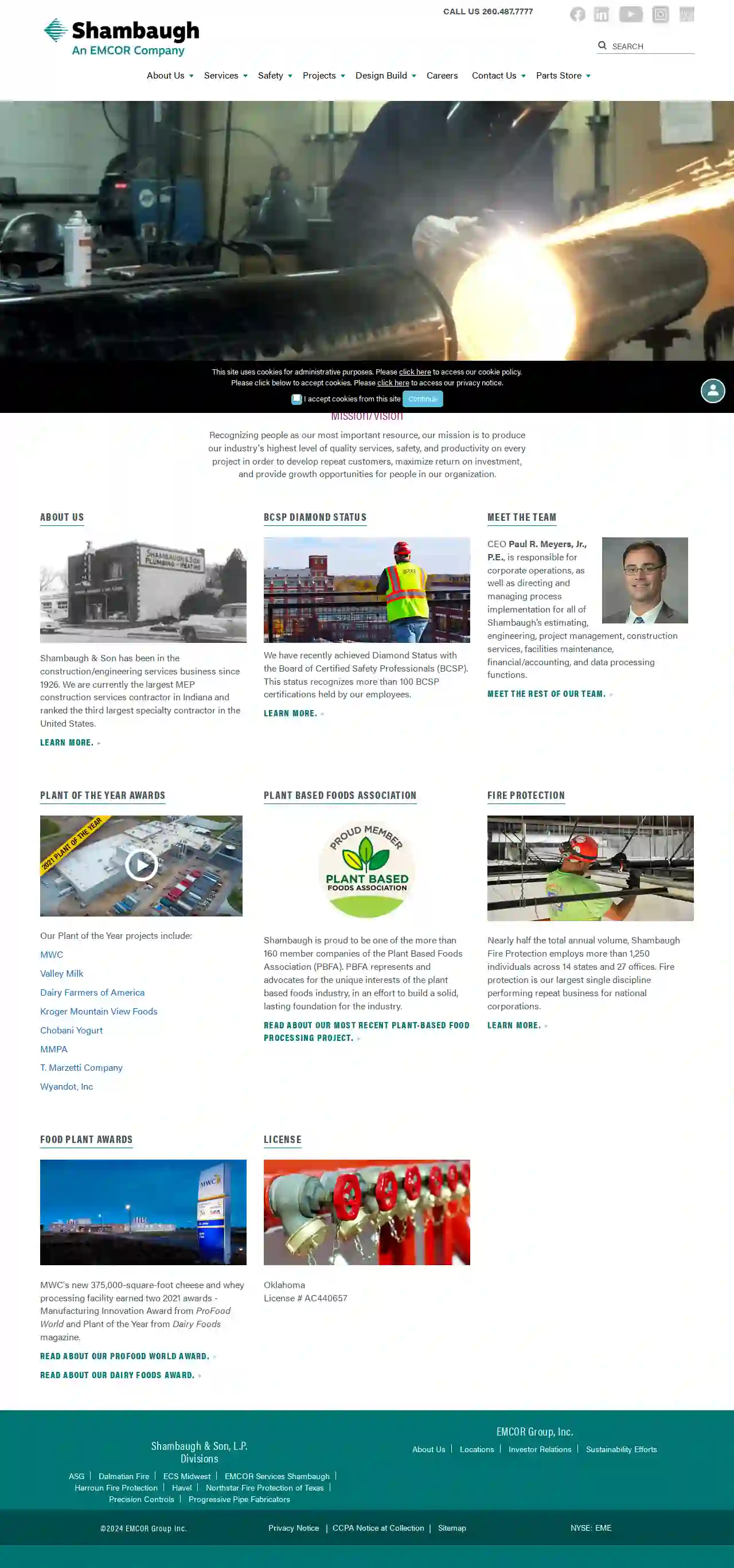
Shambaugh & Son, L.P.
4.287 reviewsWayne, USMission/Vision Recognizing people as our most important resource, our mission is to produce our industry's highest level of quality services, safety, and productivity on every project in order to develop repeat customers, maximize return on investment, and provide growth opportunities for people in our organization. About Us Shambaugh & Son has been in the construction/engineering services business since 1926. We are currently the largest MEP construction services contractor in Indiana and ranked the third largest specialty contractor in the United States. BCSP Diamond Status We have recently achieved Diamond Status with the Board of Certified Safety Professionals (BCSP). This status recognizes more than 100 BCSP certifications held by our employees. Meet the Team CEO Paul R. Meyers, Jr., P.E., is responsible for corporate operations, as well as directing and managing process implementation for all of Shambaugh’s estimating, engineering, project management, construction services, facilities maintenance, financial/accounting, and data processing functions. Plant of the Year awards Our Plant of the Year projects include: MWC Valley Milk Dairy Farmers of America Kroger Mountain View Foods Chobani Yogurt MMPA T. Marzetti Company Wyandot, Inc plant Based foods association Shambaugh is proud to be one of the more than 160 member companies of the Plant Based Foods Association (PBFA). PBFA represents and advocates for the unique interests of the plant based foods industry, in an effort to build a solid, lasting foundation for the industry. fire protection Nearly half the total annual volume, Shambaugh Fire Protection employs more than 1,250 individuals across 14 states and 27 offices. Fire protection is our largest single discipline performing repeat business for national corporations. Food Plant Awards MWC's new 375,000-square-foot cheese and whey processing facility earned two 2021 awards - Manufacturing Innovation Award from ProFood World and Plant of the Year from Dairy Foods magazine. LICENSE Oklahoma License # AC440657 Shambaugh & Son, L.P. Divisions ASG Dalmatian Fire ECS Midwest EMCOR Services Shambaugh Harroun Fire Protection Havel Northstar Fire Protection of Texas Precision Controls Progressive Pipe Fabricators EMCOR Group, Inc.
- Services
- Why Us?
- Our Team
- Gallery
Get Quote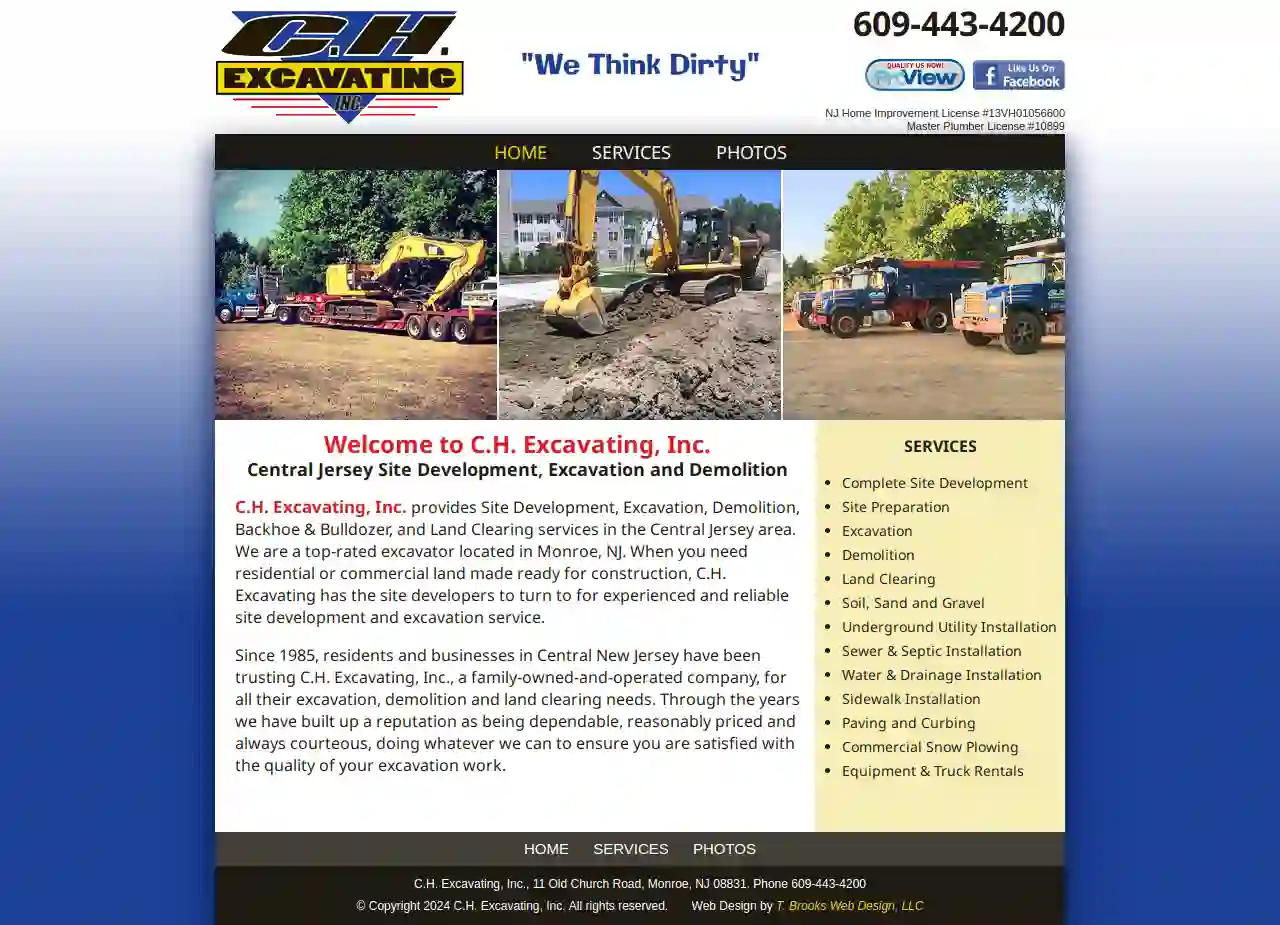
C H Excavating Contractors Inc
53 reviews11 Old Church Road, Monroe, 08831, USWelcome to C.H. Excavating, Inc. Central Jersey Site Development, Excavation and Demolition C.H. Excavating, Inc. provides Site Development, Excavation, Demolition, Backhoe & Bulldozer, and Land Clearing services in the Central Jersey area. We are a top-rated excavator located in Monroe, NJ. When you need residential or commercial land made ready for construction, C.H. Excavating has the site developers to turn to for experienced and reliable site development and excavation service. Since 1985, residents and businesses in Central New Jersey have been trusting C.H. Excavating, Inc., a family-owned-and-operated company, for all their excavation, demolition and land clearing needs. Through the years we have built up a reputation as being dependable, reasonably priced and always courteous, doing whatever we can to ensure you are satisfied with the quality of your excavation work.
- Services
- Why Us?
- Gallery
Get Quote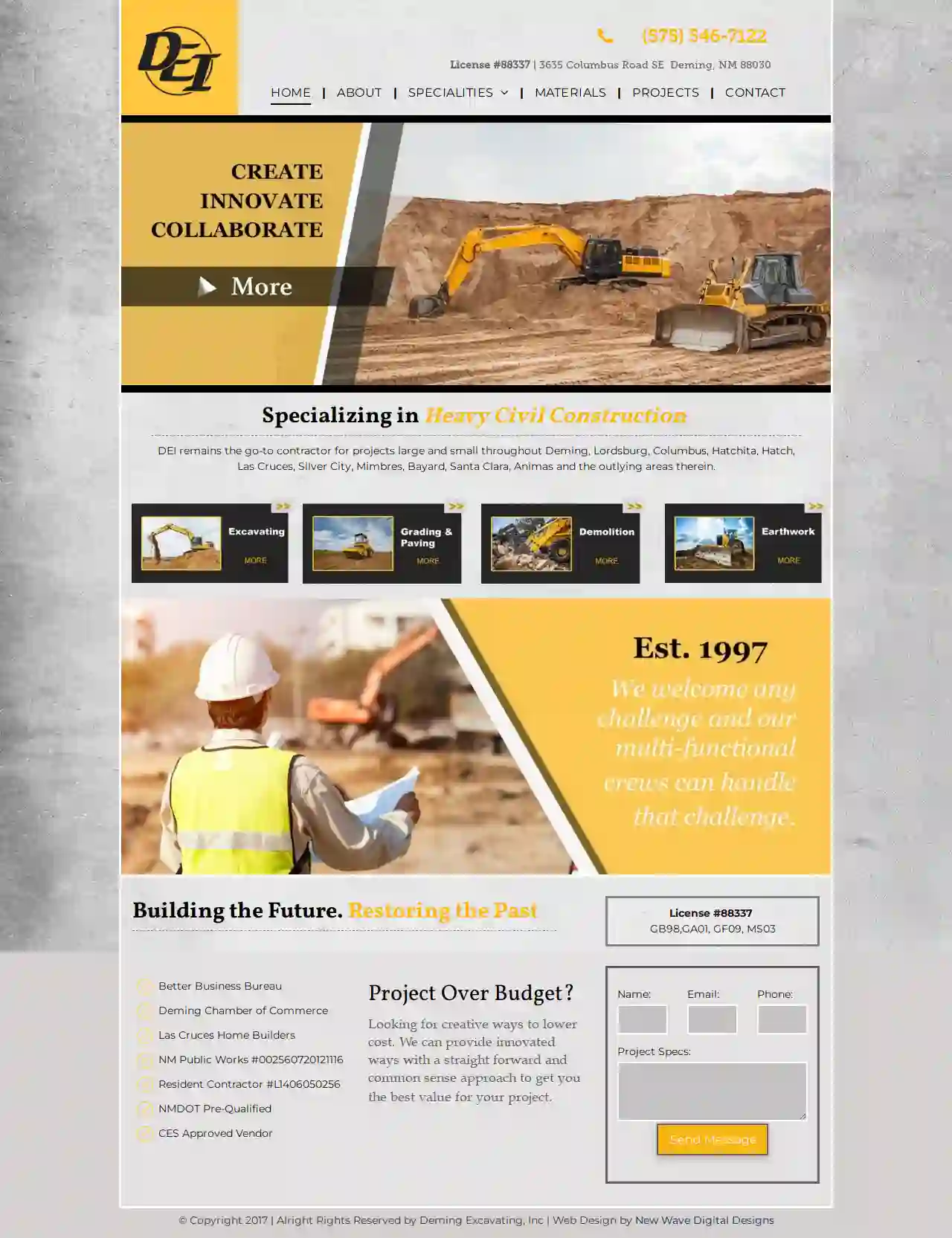
Deming Excavating, Inc.
4.712 reviews3635 Columbus Road SE, 3635 Columbus Rd SE, Deming, 88030, USAbout Deming Excavation, INC. Specializing in Heavy Civil Construction, our multi-faceted experience includes demolition, hauling, earthwork, mass grading, fine grading, wet utilities, asphalt paving, rehabilitation and maintenance, and concrete. We are a complete site development contractor. Our skilled management team is familiar in dealing with private and public agencies. We are prepared to deliver fast, professional, and on-budget services to each and every one of our clients. We believe our commitment to our customers and our work is what sets us apart and makes us the top choice in Southern, New Mexico. Building the Future. Restoring the Past Project Over Budget? Looking for creative ways to lower cost. We can provide innovated ways with a straight forward and common sense approach to get you the best value for your project.
- Services
- Why Us?
- Gallery
Get Quote
Potts Excavating Inc
4.729 reviews316 Main St, West Creek, 08092, USExcavating Contractor at Your Service! Since 1973, Potts Excavating Inc. has been a leading Excavating Contractor in Ocean County, NJ. We've provided clients with a wide range of services for all their excavating needs. Contact us today for a free estimate.
- Services
- Why Us?
- Gallery
Get Quote
Del Casale Excavating
511 reviews1000 County Route 106, Clifton Park, 12180, USDel Casale Excavating: Your Trusted Partner for Excavation Services Del Casale Excavating is a family-owned and operated business with over 20 years of experience in the excavation industry. We are committed to providing our clients with high-quality, reliable, and affordable services. Our team of experienced professionals is dedicated to exceeding your expectations and delivering exceptional results. We understand that every project is unique, and we take the time to listen to your needs and develop a customized plan that meets your specific requirements. Whether you need site preparation, foundation excavation, utility installation, or any other excavation service, we have the expertise and equipment to handle the job efficiently and effectively. At Del Casale Excavating, we are committed to safety and environmental responsibility. We use the latest technology and equipment to minimize our impact on the environment and ensure the safety of our workers and the public. Contact us today for a free consultation and let us help you bring your project to life.
- Services
- Why Us?
Get Quote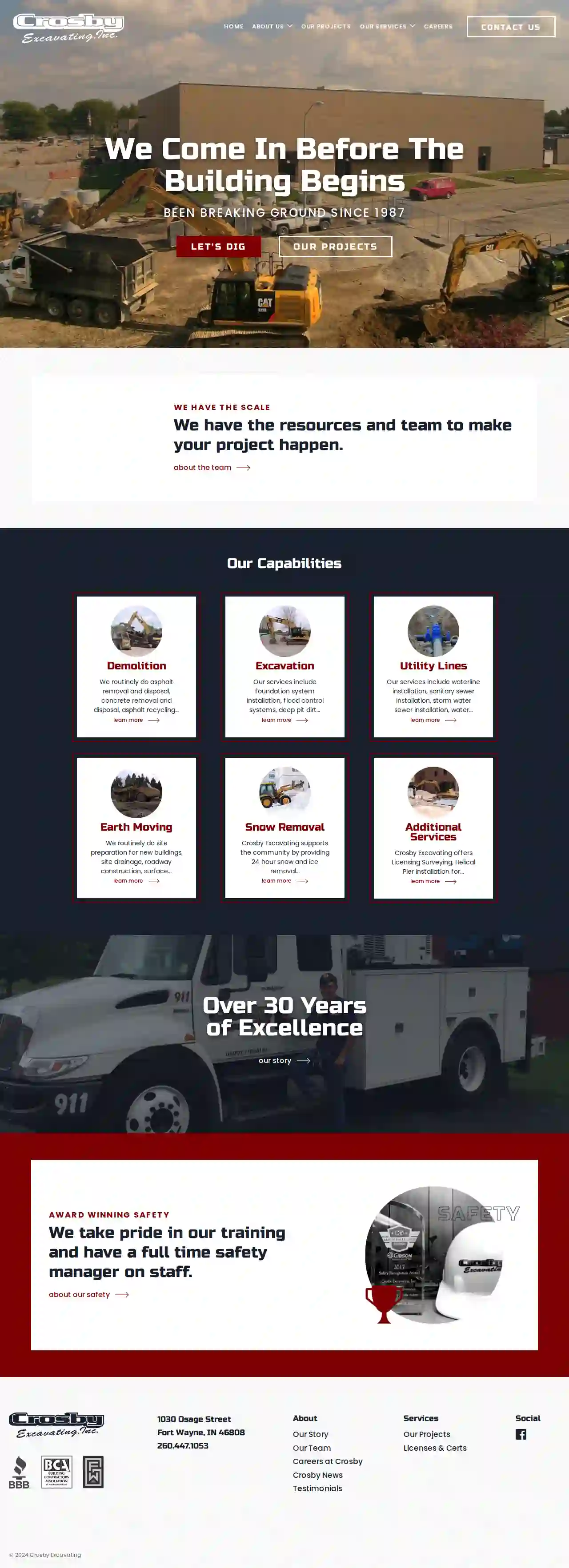
Crosby Excavating Inc
3.515 reviews1030 Osage St, Fort Wayne, 46808, USYesterday and Today One man, one truck and a vision. In 1987, our founder, Steve Crosby, had a vision, and a passion. Steve had been raised in a “construction family”. Steve’s father worked for a local construction company, and encouraged Steve to tag along with him as he went to construction sites throughout the region. It was only natural that Steve would enter the construction industry when he began his own career. Thirty-five years later, he is still here. Steve loved trucking, and moving dirt. He started Crosby Excavating very humbly, with a single dump truck. Against all odds, and through sheer determination and dedication, Steve’s little company began to take shape. One truck led to two, then his first employee, and the die was cast. Crosby’s fleet of trucks grew, as did the type and size of equipment. Today Crosby Excavating operates from its renovated facility at 1030 Osage Street, near downtown Fort Wayne. The four acre site also includes a fully staffed maintenance shop and covered equipment storage area. As a result of its focus on quality, on time performance, and cost effective pricing, Crosby Excavating is enjoying steady growth in all of its market segments. This growth has allowed Crosby Excavating to attract the best talent in the region, making Team Crosby the envy of the industry. In order to keep up with the demand for its services, Crosby Excavating has been acquiring new and more efficient capital equipment. Whether it’s pavement demolition, earth moving, excavation, or snow removal, Crosby has the right piece of equipment to do the job. No job is too large or too complex for Crosby Excavating. In 2013 Crosby Excavating grew 93 percent when compared to 2012. Growth continues at an impressive rate, in all areas of its business. This growth is the result of Crosby’s core principles: Safety first Do it right the first time Do it on time Provide unsurpassed value to our clients Crosby Excavating has been providing total site development services since 1987. It has never failed to complete a contract, and stands ready to perform for you. Our Mission We strive to maintain the highest degree of technology in the industry, so that we can offer our customers the best solutions to their needs. All Crosby Excavating employees are dedicated to the understanding that our customers are the most important people. Our customers are NOT dependent on us….we are dependent on them. Our company will continue to thrive and grow by maintaining our mission and our commitment to our customers. Award Winning Safety We take pride in our training and have a full time safety manager on staff.
- Services
- Why Us?
- Testimonials
- Gallery
Get Quote
Next Level Excavation
54 reviewsEgg Harbor Township, USFamily owned and operated Bring your projects to the Next Level Who we are Doug is the owner and operator of Next Level Excavation. Doug has over 18 years experience in all types of excavation. From small residential projects to large commercial projects we have you covered! Safety is our standard. All employees are O.S.H.A. Certified Fully licensed and insured Over 18 years of experience Services Excavator and skid steer services Brush removal Bulk trash hauling Concrete removal Drainage systems Fence/deck/shed demolition and removal Trenching of any kind Stone driveways Grading Dump trailer rental Material hauling Much more… Prompt and Reliable Satisfaction Guaranteed
- Services
- Why Us?
- Our Team
- Gallery
Get Quote
Niblock Excavating
11 reviews906 Maple St, Bristol, 46507, USFull Service. Family Run. Formidable Capabilities. For over seven decades, Niblock has been delivering top-notch earthwork, underground utility work and paving in Northern Indiana and Southern Michigan. With a crew over 100 strong, we handle all facets of large civil work while offering the efficient communication and personalized service of a family run company. The Niblock Difference Done Right the First Time, Every Time It’s a cliche claim, but no less true. We hold ourselves to the highest standards in all we do. In fact, we’ve actually turned down work when specifications don’t meet our standards. When you choose Niblock, you can count on long term durability. More than Muscle, Experienced Problem-solving Partners With decades of experience, we’ve seen it all. We’re always on the lookout for ways to improve performance and make your application more efficient. We’ve helped clients reroute access and layout for better traffic flow, spotted ways to improve drainage, dramatically expand capacity with minor alterations, and more. Tightly Coordinated, Family Run We pack big capabilities into a small-company feel, enabling us to communicate more efficiently and eliminate approval bottlenecks. You’ll get personalized service and a simple, single point of contact for all of your job needs. On Time and On Budget It seems delays and overruns are standard operating procedure for many, but not at Niblock. We’re experienced and realistic in our projections. We pride ourselves on sticking to our budget and deadline commitments. A Steady History You can Count On For three generations, Niblock has been delivering top-notch work in Northern Indiana and Southern Michigan. We have a stable, long-term track record. When we say we stand by our work, you can be assured we’ll be here to do just that for many years to come.
- Services
- Why Us?
- Gallery
Get Quote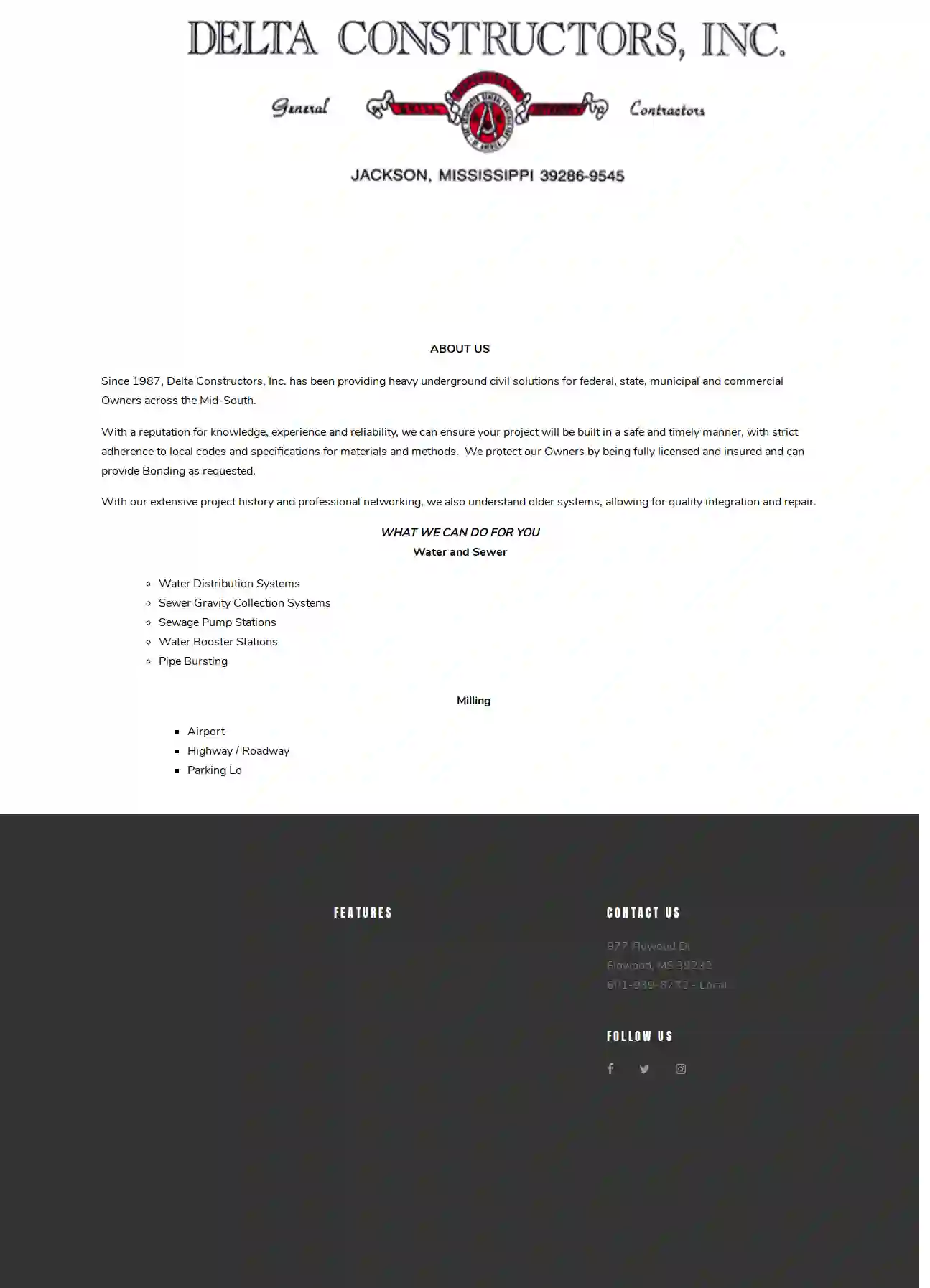
Delta Constructors, Inc.
4.610 reviews977 Flowood Dr, Flowood, 39232, USAbout Delta Constructors, Inc. Since 1987, Delta Constructors, Inc. has been providing heavy underground civil solutions for federal, state, municipal and commercial Owners across the Mid-South. With a reputation for knowledge, experience and reliability, we can ensure your project will be built in a safe and timely manner, with strict adherence to local codes and specifications for materials and methods. We protect our Owners by being fully licensed and insured and can provide Bonding as requested. With our extensive project history and professional networking, we also understand older systems, allowing for quality integration and repair.
- Services
- Why Us?
- Gallery
Get Quote
Structure Tone LLC
56 reviewsWoodbridge, USWho We Are We are a family of companies building amazing spaces across the US, Canada, UK and Ireland. History Founded in 1971, we have grown into an organization made up of over 4,700 employees across 54 offices.
- Services
- Why Us?
- Gallery
Get Quote
Over 22,076+ Excavation Contractors onboarded
Our excavation experts operate in Ramtown & surrounding areas!
ExcavationHQ has curated and vetted the Best Excavation Companies near Ramtown. Find a top & reliable pro today.
Frequently Asked Questions About Demolition Contractors
- Project Assessment: The demolition contractor evaluates the structure, site conditions, and project requirements.
- Permitting: Obtain necessary demolition permits from local authorities.
- Site Preparation: Secure the site, disconnect utilities, and remove any valuable or reusable items.
- Hazardous Material Abatement: Professionally remove asbestos, lead paint, or other hazardous materials if present.
- Demolition: Execute the chosen demolition method, bringing down the structure safely and efficiently.
- Debris Removal and Site Cleanup: Sort, process, and dispose of demolition debris responsibly. Clean up the site to prepare it for future use.
- Permits and Regulations: Obtain all necessary demolition permits and comply with local building codes and environmental regulations.
- Contracts: Have a clear and comprehensive contract with the demolition contractor outlining the scope of work, payment terms, and liabilities.
- Environmental Laws: Comply with environmental laws regarding hazardous material removal, waste disposal, and pollution control.
- Neighboring Property Rights: Respect neighboring property rights and take measures to prevent damage or disruption to adjacent properties.
- Worker Safety: Adhere to worker safety regulations and provide a safe working environment for demolition crews.
How can I tell if my building contains asbestos?
What are the steps involved in a typical demolition process?
What are the legal considerations for demolition projects?
Can I do demolition myself?
How can I tell if my building contains asbestos?
What are the steps involved in a typical demolition process?
- Project Assessment: The demolition contractor evaluates the structure, site conditions, and project requirements.
- Permitting: Obtain necessary demolition permits from local authorities.
- Site Preparation: Secure the site, disconnect utilities, and remove any valuable or reusable items.
- Hazardous Material Abatement: Professionally remove asbestos, lead paint, or other hazardous materials if present.
- Demolition: Execute the chosen demolition method, bringing down the structure safely and efficiently.
- Debris Removal and Site Cleanup: Sort, process, and dispose of demolition debris responsibly. Clean up the site to prepare it for future use.
What are the legal considerations for demolition projects?
- Permits and Regulations: Obtain all necessary demolition permits and comply with local building codes and environmental regulations.
- Contracts: Have a clear and comprehensive contract with the demolition contractor outlining the scope of work, payment terms, and liabilities.
- Environmental Laws: Comply with environmental laws regarding hazardous material removal, waste disposal, and pollution control.
- Neighboring Property Rights: Respect neighboring property rights and take measures to prevent damage or disruption to adjacent properties.
- Worker Safety: Adhere to worker safety regulations and provide a safe working environment for demolition crews.